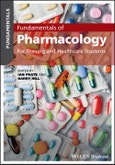All registered nurses must have a thorough understanding and a strong knowledge of pharmacology, medicines administration, and the ability to recognise and react to the effects of medicines. Fundamentals of Pharmacology helps nursing and healthcare students develop the skills and confidence required to apply the fundamental principles of pharmacology and to offer safe, competent and compassionate care. Concentrating on the medicines that students are most likely to encounter in real-world practice, this textbook provides concise coverage of pharmacology, essential medicines management principles, legal and ethical issues, drug formulations, analgesics, immunisations, and much more.
Clinically focused chapters feature defined learning outcomes, multiple-choice questions, practical examples, and full-colour illustrations to aid readers’ comprehension of the complexities of pharmacology and care provision. The book utilises a straightforward, student-friendly approach to present ‘must-have’ information, with contributions from experienced clinicians and academics.
- Describes how to use pharmaceutical and prescribing reference guides
- Stresses the role and importance of compassionate care throughout
- Contains a full range of pedagogical tools which enhance learning and recall
- Aligns with current NMC Standards and Proficiencies for Registered Nurses and Nursing Associates
- Supplemented and supported by a wealth of online extras and resources
Fundamentals of Pharmacology is essential reading for all nursing students, trainee nursing associates, post-registration nurses taking ‘nurse prescribing’ or ‘non-medical prescribing’ modules, and newly qualified nurses and nursing associates looking to better understand pharmacology.
Table of Contents
Chapter 1 Introduction to pharmacology 1
Ian Peate
Chapter 2 How to use pharmaceutical and prescribing reference guides 15
Claire Pryor and Annette Hand
Chapter 3 Legal and ethical issues 33
Claire Leader, Emma Senior and Deborah Flynn
Chapter 4 Medicines management and the role of the healthcare provider 49
Annette Hand and Carol Wills
Chapter 5 Pharmacodynamics and pharmacokinetics 69
Barry Hill and Jaden Allan
Chapter 6 Drug formulations 91
Hayley Underdown and Nicola Clipperton
Chapter 7 Adverse drug reaction 111
Laura Park and Michelle Mitchell
Chapter 8 Analgesics 127
Claire Ford and Matthew Robertson
Chapter 9 Antibacterials 153
Deborah Flynn
Chapter 10 Medications used in the cardiovascular system 187
Jan Guerin and Cecilia Mihaila
Chapter 11 Medications and the renal system 225
Sadie Diamond‐Fox and Alexandra Gatehouse
Chapter 12 Medications and diabetes mellitus 285
Anne Phillips
Chapter 13 Medications and the respiratory system 313
Sadie Diamond‐Fox and Alexandra Gatehouse
Chapter 14 Medications and the gastrointestinal system 369
David Waters and Ian Naldrett
Chapter 15 Medications used in cancer 389
Elaine Walls and Leah Rosengarten
Chapter 16 Medications and the nervous system 415
Julie Derbyshire
Chapter 17 Medications used in mental health 437
Laura Stavert
Chapter 18 Immunisations 465
Aby Mitchell
Normal Values 491
Answers 495
Index 49







